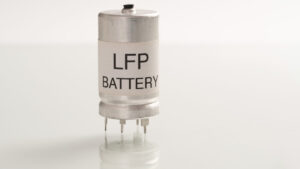ROCK STAR: Centrex’s fortunes mirror that of the phosphate sector, and here’s what’s making it tick

Picture: Getty Images
Much has been made about securing energy and critical mineral supply chains. The need to secure food production and its relevant supply chains – particularly for phosphate and potash fertilisers – is equally as important, if not more so.
And some investors are certainly clued in if the steady rise of Centrex Metals (ASX:CXM) – from 2.1c in mid-March 2020 to the current share price of 16c – is any indication.
It is not unreasonable to speculate that a large part of this is due to the fact that the company’s Ardmore project in Queensland is already producing rock phosphate – with the first shipment exported from Townsville in September 2022.
Rock phosphate sales in the current quarter hit 23,053Mt as of March 22 2023, close to its target of 26,000t for the quarter, and is expected to reach 45,000t in the June quarter.
Recent developments also provide the basis for further growth. These include the signing of binding offtake agreements with Ameropa Australia and Ballance Agri-Nutrients, as well as the Federal Government’s Northern Australia Infrastructure Facility moving to detailed due diligence regarding NAIF’s participation in the Stage 1.5 expansion of the Ardmore project.
It’s hard to argue after all with the guaranteed purchase of between 15,000t and 16,000t of phosphate in the first year from Ameropa and about 30,000t in the first year from Ballance as well as the prospect of securing funding that can be allocated towards the capital costs associated with the expansion.
Stage 1.5 targets production of 625,000tpa by using existing facilities on site and represents an interim stage towards 800,000tpa phosphate output in Stage 2.
However, at least a part of Centrex’s growth is due to the strong fundamentals for phosphate and under fertilisers as the world’s population continues to grow.
Why phosphate?
Rock phosphate is used to make organic phosphate fertilisers, which are rich in phosphorous and work with soil rather than against it.
High quality rock phosphate can also be used as direct-application fertilisers that do not require chemical reaction with sulphuric acid to make the phosphate derivative products and as such can be produced at a discount while also trading at a premium to processed phosphates.
Phosphate fertilisers see widespread use and at least one source has forecast that the market could grow at a compound annual growth rate of 5% between 2022 and 2028 to reach a value of US$90.25bn.
It is also worth noting that these are completely different from potash fertilisers, which are rich in potassium and sulphur.
Following a period when prices of phosphate fertiliser increased rapidly due to rising input costs – particularly ammonia, which itself rose due to surfing natural gas prices – prices are now expected to fall modestly in 2023 and 2024.
However, demand is likely to remain high. In fact, CRU estimates demand could climb about 200Mt in 2021 to almost 300Mt by 2045.
Australia itself imports about 400,000t of phosphates
Meanwhile, China, which accounts for 30% of global trade in phosphate fertilisers, has put into place export restrictions that reduce the amount of supply going into the market.
To compound things, phosphate is also seeing increasing use in the battery sector due to the growing popularity of lithium iron phosphate (LFP) batteries that trade some energy density for safety, lower cost and longer life spans.
ASX juniors
So besides Centrex, just who are the junior ASX resource companies with significant phosphate assets?
The company is focused on developing its Wonarah phosphate project in the Northern Territory, which has a total resource of 533Mt with 64.9Mt at 22.4% phosphate in the ultra-high confidence Measured category and 133Mt at 21.1% phosphate in the Indicated resource category.
Wonarah is one of Australia’s largest phosphate projects and is close to excellent infrastructure including road, rail, gas and water.
Avernira has been assessing the viability of a direct shipping ore (DSO) operation with marketing samples supplied to potential offtake producers, progress made on a Mining Agreement with the Arruwurra Aboriginal Corporation, and drafting a Mine Management Plan for the trial pit for a potential offtake trial shipment.
This includes identifying and obtaining quotes from various logistics providers for potential ore transport to port as well as advancing a feasibility study.
A Scoping Study is also underway to develop the project to produce critical end products for LFP batteries.
Phosphate miner CI Resources produces phosphate from its operations on Christmas Island.
In the first half of the 2023 financial year, it generated phosphate and fertiliser sales volumes of about 275,000t, which resulted in a net profit of $29.23m.
Fertoz owns the Wapiti and Fernie phosphate projects in British Columbia, Canada, which are located near conventional and organic agricultural regions.
This is turn allows them to use existing rail and road infrastructure to access not only the US but also Northwestern, Northern, and Central Canada.
Wapiti already has an Inferred JORC resource of 1.54Mt, though just 20% of the exploration licence has been explored to date while Fernie is a large portfolio of permitted exploration licences and is also the subject of an industrial mining permit (for up to 100,000tpa) that was lodged earlier this year.
Additionally, Fertoz has already received initial orders for 18,000t of its Fertify product – a 40%/60% blend of rock phosphate with litter (nitrogen) and is on track to deliver 40,000t of rock phosphate in 2023.
It has also signed a 10-year rock phosphate offtake agreement with a key fertiliser manufacturer in North America, which is expected to deliver 120,000t in the first five years.
Additionally, the company has secured a 10-year lease agreement to continue rock phosphate mining operations at Deerlodge in Montana, US.
Meanwhile, Minbos is making good progress towards becoming a phosphate fertiliser producer from its Cabinda project in Angola with first output expected in the fourth quarter of 2023.
Recent work on plant optimisation and flowsheet work has identified capital core savings of about US$10m by simplifying the flowsheet to produce beneficiated phosphate rock.
The simplified flowsheet is also expected to deliver lower operating expenses due to lower energy, maintenance and fixed cost requirements.
Cabinda project life is currently estimated at 20 years, based on the defined ore reserve with a production schedule outlined in the Definitive Feasibility Study envisaging a ramp-up to full production of the facility over seven years.
PhosCo’s Chaketma phosphate project in Tunisia is the subject of a Scoping Study which has outlined solid economics including after-tax net present value and internal rate of return – both measures of a project’s profitability – of US$657m and 54% respectively.
Capex is estimated at US$170m with payback in just 1.5 years from the start of commercial production.
Open pit mining and processing is expected to deliver 1.5Mtpa of high-quality concentrate with greater than 30% phosphate and less than 1% magnesium oxide.
Chaketma is also expected to be a generational project with a long mine life of 46 years.
Additionally, there is potential for the project to deliver higher production rates to match market demand with nearby deposits already identified for lower mining costs, including the SAB prospect.
While RareX is primarily focused on rare earths, phosphate makes up such a substantial portion of its flagship Cummins Range project that the company has flagged its potential to produce both a direct shipping ore (DSO) and a phosphate mineral concentrate.
Testing has already indicated that Cummins Range phosphate has between two to five times better bioavailability than the industry standard for high-bioavailable rock phosphate, making it ideally suited for the production of organic fertilisers.
And while the project will initially produce DSO with low levels of processing and capital, testwork has already indicated that a simple beneficiation flowsheet and low reagent consumptions are all that are needed to produce a phosphate concentrate.
To top it off, RareX has just upgraded its phosphate resources by 800% and REE resources by 500% to 16.7Mt phosphate and 1.3Mt TREO due to successful drilling that led to its realisation that the deposit is a very large REE-rich phosphate system.
Related Topics
UNLOCK INSIGHTS
Discover the untold stories of emerging ASX stocks.
Daily news and expert analysis, it's free to subscribe.
By proceeding, you confirm you understand that we handle personal information in accordance with our Privacy Policy.








